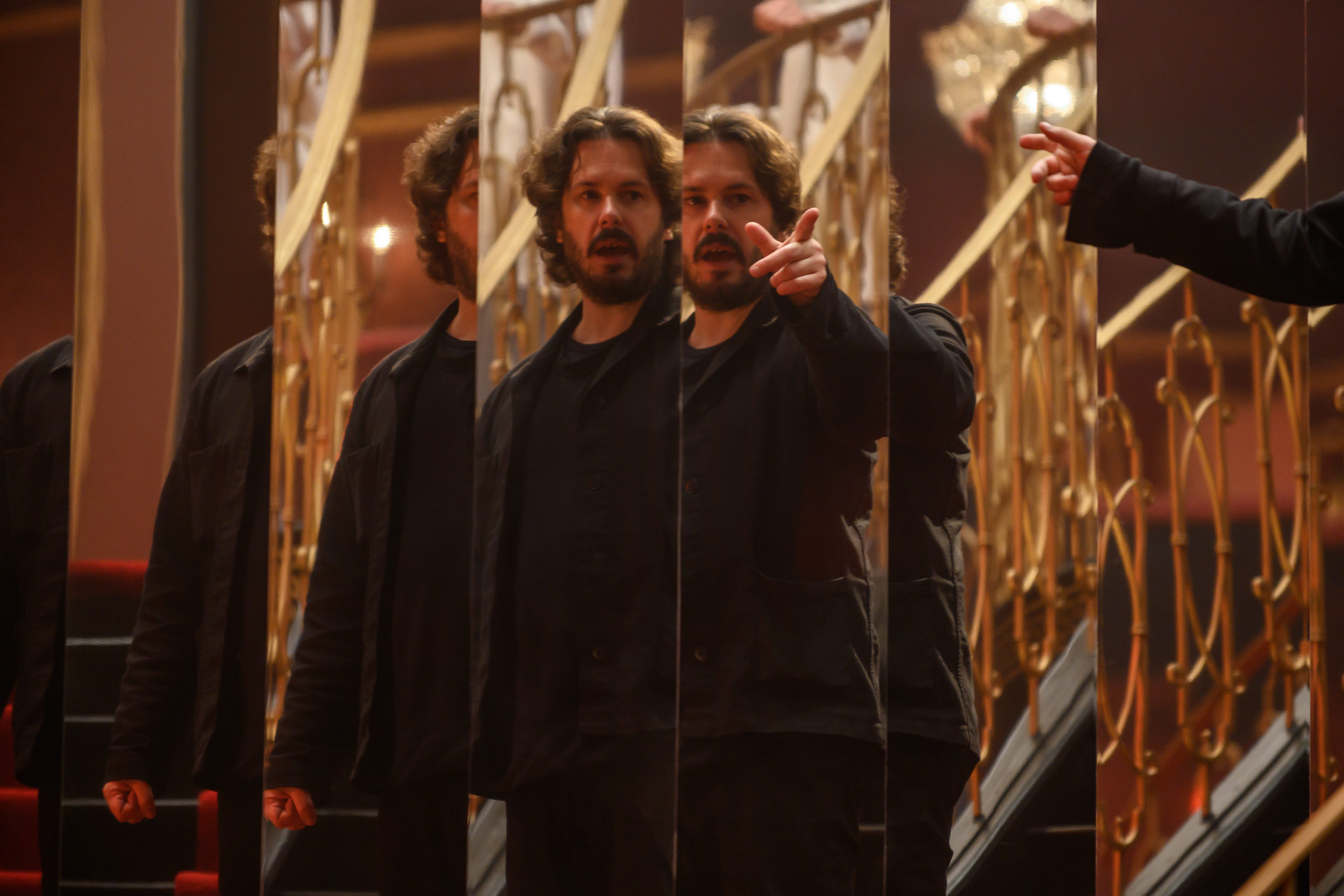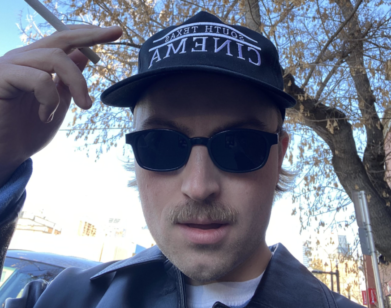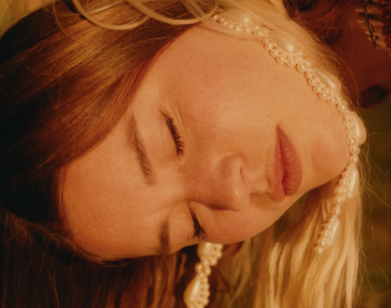DIRECTORS
Edgar Wright and Cary Fukunaga Go Deep on the Art of Making Movies

Credit: Parisa Taghizadeh / © 2021 Focus Features, LLC.
Edgar Wright is back. The director, who kept busy during the pandemic by releasing the music documentary Sparks, had to wait a little longer for his latest genre exercise to hit theaters. Last Night in Soho, which was delayed by a year and marks his official follow-up to the suprise hit Baby Driver, is a psychological horror starring Thomasin McKenzie as an aspiring fashion designer who is haunted with visions of a mysterious woman in 1960s London, played by Anya Taylor-Joy. The film, which doubles as love letter to the city Wright calls home and an ode to the European thrillers of his youth, is once again packed with references and the kinetic style Wright has become known for. To mark its release, Wright hopped on a call with Cary Fukunaga, another filmmaker who knows a thing or two about delayed movies, to discuss the psychological toll of moviemaking, reshoots, challenging audience expectations, and ghosts, both real and imagined. —BEN BARNA
———
CARY FUKUNAGA: How are you?
EDGAR WRIGHT: I’m good. On one hand, I’m really excited for the film to come out, and that people are going to see it in the cinema, but I’ve also started to feel this growing sense of imminent grief, that the film is leaving home, like a child. I started to think, “What am I going to do when I’m not making or talking about Last Night in Soho anymore?” It feels like I’m about to become an empty nester. Did you feel a similar way with Bond at all? You must’ve felt a huge sense of relief about it coming out.
FUKUNAGA: I did, but I’m also on day 96 of a different production. I’m at a different kind of fatigue level right now. I think I faced what you’re talking about at the exact same time as the entire world shut down. We wrapped up, were ready to start the world tour, and then everything shut down. I landed on the shores of the United States in a home that I hadn’t lived in in two years, and had to face the emptiness and the quiet, then and there. But the emptiness is important because it’s there that all the questions come up. Questions and answers that somehow spark a fire for new ideas. For me, the ideas don’t come when you want them to come. They come at random times. You can be in the shower, on a drive, talking to somebody about something tangential, and then you need to write it down immediately. Do you also get your ideas in that vacuum?
WRIGHT: I’m hoping that’s what happens. I keep getting asked in interviews, “So what’s next?” And it feels like I’m giving them a bullshit non-answer by saying, “I really don’t know, I have to get through this, and then I have other scripts.” I have to get to either a literal or metaphorical clean-desk moment where I can start a day by not answering emails about Last Night. The tricky thing for me is that I’m looking forward to doing something new, but I feel like I may have made a mistake by making the movie where I live, because I can see where Thomasin McKenzie’s character lives in the film from my balcony.
FUKUNAGA: Staring you in the face, everyday.
WRIGHT: I have this theory that if a film is something that’s kind of self-generated, the idea is haunting you, and the only way to get it out of your head is by making it. That’s a big part of the process, but I feel like I may have made a tactical error by making a movie literally where I live.
FUKUNAGA: Let’s talk about themes. Similar to me, a lot of your films are quite different; they go to different worlds and different genres. Have you ever thought about continuing one genre to where it becomes almost your identity?
WRIGHT: It’s a good question. I feel sometimes like the process of making a movie is that you’re on the psychiatrist’s couch, and it takes somebody else—like an audience member or a critic—to tell you what you’ve done. At the end of each project, there’s something that was really thrilling to do, and I try to find a way of continuing that in a different story. It would probably be a bad idea for me to jump straight into another psychological-thriller horror-movie right now, but there were some parts of it that were so thrilling to do, that I find myself thinking, “What can I do where I can get that same kind of high it from making it?” I don’t think I’ve ever done exactly the same thing twice in a row. In fact, the reason I decided to do Last Night in Soho was because at the time when Baby Driver was out, it was doing an awards run and got Oscar nominations, and I was getting a lot of pressure to jump straight into doing a sequel. And I just wasn’t ready to do the same story again. It was a conscious thing of switching gears.
FUKUNAGA: If you did a Baby Driver 2, would you be afraid that you would be selling yourself out creatively?
WRIGHT: If I did the sequel—and in fact I’ve already written a script—I’d have to find a way to make it fun for me. The idea of doing a straight Xerox is just not interesting because, as you know, these films take at least two years and in our cases, because of the pandemic, they took even longer. My rule of thumb is you have to really want to do it. We’ve both been in situations where we have walked away from a studio franchise movie because we weren’t feeling it. I know that we share many things in common, and that’s one of them.
FUKUNAGA: Also, in Baby Driver, you explored that first as a music video, and then that became a feature. So it’s already like you’ve taken the kernel and expanded it. To expand it again maybe wouldn’t be as satisfying to you.
WRIGHT: That’s definitely true. And then there’s the exceptions to the rule, like when you hear, “George Miller is doing a fourth Mad Max film? I wonder what that’s going to be like?” And then you see Mad Max: Fury Road and you see that it is obviously something where he’s taken what he had before, and managed to realize it on a whole other level that is extraordinary.
FUKUNAGA: That’s true. Let’s jump back to music. Last Night in Soho starts off with a very strong musical presence, and one thing I know that you do annually is your playlist. Can we talk about how your playlists work in terms of not only making it and sharing it, but also what ends up being inspirational for your film projects?
WRIGHT: The reason I do those end-of-year playlists is that it forces me to listen to lots of new music, because I think too often you can get into a rut of listening to the things that you like. I’m quite voracious in terms of listening to music. In Baby Driver, the character listens to music to drown out his tinnitus. In a similar way, I’m somebody that has to listen to music for motivation, and I’m not really comfortable with quiet, so I do have almost like a running soundtrack. And then in writing, the motivation to make the movie and the internal momentum to get it going starts with the soundtrack. The songs that are on the Last Night in Soho soundtrack, I was amassing them over the course of a decade. And then they would almost become Post-it notes on the fridge. If I heard them, I’d think, “I must make Last Night in Soho.” The songs were just these ghostly reminders to actually knuckle down and write the screenplay.
FUKUNAGA: Have you ever thought about doing a movie with no music at all, including score?
WRIGHT: It would be nice to do. It’s nice to think about doing projects where you take out something so you’re not relying on it as a crutch. Is there something that you would look forward to denying yourself in a future production?
FUKUNAGA: I think score would be one of them, just because it’s such a strong tool to shape emotional reactions. I’m not going to say it’s an easy tool, because it’s very difficult to play music well. But it’s a strong tool, and I think another obstruction that would be interesting is doing a movie with hardly any plot.
WRIGHT: Antonioni’s L’Avventura is a great example, where the film itself is just an existential riddle to baffle audiences around the world.

Cary Fukunaga on the set of No Time to Die. Photo by Nicola Dove.
FUKUNAGA: The discomfort factor is really interesting. I wonder how you think about this, but oftentimes I think of my job as a director is to put the audience at ease early as to what they think the movie is going to be about, and then try to make it as seamless as possible when you’re subverting that and surprising them. That’s the constant challenge, to achieve that level of suspension of disbelief. And the danger is that if the audience has no idea what they’re watching, they’re constantly pulling themselves out of the experience of watching the film. So how do you keep them engaged?
WRIGHT: Well, Last Night in Soho is like that in terms of it being a slow burn. The first 25 minutes of the film is a lot quieter than my other movies and that was always the intention, because the premise of the movie is Thomasin McKenzie’s character is seduced by the allure of going back in time, in the same way that Anya Taylor-Joy’s character is dazzled by the bright lights of the West End. And then, once it starts to get darker, you’re trapped on a kind of a roller coaster that you can’t get off. That was always the way it was conceived. A lot of generic horror movies have that thing where they’ve got to have a big jump every 10 minutes. This is something different. I want it to feel like a very experiential movie, where Thomasin’s character is in every scene—you’re seeing the film completely through her eyes, and you’re going down the rabbit hole with her. And there’s no way out of it because, as an audience, you only have the information that she has, and she has this supernatural gift, but she doesn’t always have the full context of what she’s seen.
FUKUNAGA: When Pixar makes a movie, they make it four times over. They do it with script, with audio, and animatics. They do it for years before they actually go to final rendering on these films. And there’s something about the humor, the pacing, what information lands, that you can try out over and over again until you make the actual film. When I make movies, I’ve only been able to go back and do pickups once. Other than that, every movie or TV show I’ve ever done, we wrap and that’s it. There’s no going back. It would be so amazing to workshop a film that way.
WRIGHT: Reshoots are often seen as a negative term, where the studio is making you do something you don’t want to do. But for filmmakers, if it’s something they want to do, it’s called additional filming. That’s my theory.
FUKUNAGA: [Laughs] It’s not a reshoot. We didn’t do it wrong the first time. It’s a pickup. Let’s talk about ghosts. I think this is a fascinating part of your film, and when I saw it, I couldn’t help but think about an article I read that talked about the cross between schizophrenia and those who talk to and see ghosts. Let’s just ignore the fact that there are people who don’t believe in ghosts. I believe in ghosts. I’ve had experience with ghosts. I’ve learned things from ghosts you couldn’t have known otherwise. I’m pretty sure I’m not schizophrenic, but I have another friend who’s schizophrenic, and she’s talked to ghosts. She’s talked to ghosts, for example, in my house. She knew exactly where to go in the house; I knew exactly where the ghost was, and she didn’t. She walked into the house and knew exactly where to go. I left her, and she had a conversation with the ghost for 30 minutes.
WRIGHT: I don’t quite have the same experience, but I have a similar one. My mother is like Eloise in the movie, very supernaturally switched on. She feels presences in old buildings and has seen ghosts in my family house I lived in from the age of eight to 20. My mom would talk about it in a very matter-of-fact way to me and my brother. She would say, “I saw the ghost of the hangman in the living room this morning and I told him to piss off and he disappeared.” Now, me and my brother were both a) very ghost curious and b) not skeptical and just accepted it as fact. But also, I believed her, and I do believe her, but I also knew enough that I wouldn’t go to the playground at school the next day and tell my friends that my mom saw the ghost of a hangman in the living room. And there’s something like that in the movie like that, where Thomasin goes to the police to explain what she’s seen, and obviously they’re looking at her like she’s insane.
FUKUNAGA: It’s that classic thing in horror films, where you want the character to say it in a way that you know the police will understand better. But that’s her obstruction; that’s her character block at that moment.
WRIGHT: It’s all about context. Yes, she’s seen the right thing, but she hasn’t seen the full context of events. When I showed my mother the movie the other day, she immediately started talking about all of her ghostly experiences growing up. This sounds like the plot from an Amityville film, but when we were doing renovations in our house, we found a walled-up room that had been walled-up for tax reasons decades before. And they discovered that the previous inhabitants had had a mentally deficient child. Back in the day, it was a source of shame for that kind of child to be seen in public, so they lived and died in the room. And so my mom goes “Oh, this is the child that was haunting you.” And I said, “What do you mean?” and she goes, “Do you remember when you kept feeling like somebody was calling your name, and you came down and said, ‘Mom what do you want,’ and I said ‘I didn’t say anything.’” After seeing the movie she told me the story again, and I said “Yes, I do remember that now.” So that was the household I grew up in. Also, as a young horror fan, there was a part of it where I was envious that she had seen a ghost and I hadn’t. So I’m also envious that you have communicated with a ghost.
FUKUNAGA: Don’t be envious. Trust me.
WRIGHT: Would you want to tell me a little bit about that?
FUKUNAGA: Well, I’ve had a couple experiences, but one was in my house in New York. He was sad and lonely and waiting for this woman to come back to him. When I was living in London, I started having a poltergeist in my apartment that would turn lights on when I was away and had a very strong B-O smell. I couldn’t wash the smell out; I washed everything in the apartment with very strong chemicals, but there was just one column of air of B-O. And then later on, a ghost appeared in that same column of space, and it happened to coincide with the discovery of one of Shakespeare’s lost theaters, off Curtain Road, which was called, “The Theatre.” It was an octagonal brick theater that they knew existed, but they didn’t know where it was. They’d done some work on a building next door, and it turned out it was underneath our building, and part of it was exposed in the next door building. And so when the thing appeared, it had ruffles around its neck with a long cloak. That was that ghost. I have no idea what it wanted, or why it was there watching me, but my apartment would have been in the upper echelon of the theatre. The one in Mexico was the most frightening and I don’t think we have time for it. I’ll tell you just one-on-one.
WRIGHT: Here’s another thing, and maybe this is too big to get into, but there’s also the two theories about ghosts: The more traditional theory, in horror novels and stuff like that, is a ghost is a soul left on earth in purgatory with unfinished business and unable to go to heaven or hell. And then the other theory, which is covered in Nigel Kneale’s great TV movie The Stone Tapes, is the idea of a haunting being the psychic residue of an event. I don’t have the scientific explanation for this, but it’s something like: if a murder happened in a room would that be any like psychic residues left behind? Even just the emotional echo of the event?
FUKUNAGA: The one in Mexico was absolutely an echo of a real event, and what I saw and heard was then confirmed later on outside of me. But I’ve also been asked to transmit a message to someone still alive from a dead person. That episode confused me, because that’s expressing a desire and will beyond the grave. Prior to that, I’d always believed it’s an echo; it’s the energy that exists, and you can kind of walk into it like a radio wave and interpret it. Or it’s just so piercing that it travels through time. But beyond the grave will? I don’t know where that comes from. I don’t have a system to describe that.
WRIGHT: I’ve never been somebody that feels like I’ve ever really had that experience, like my mother has, and I’ve always felt slightly bereft that I haven’t. Maybe, in a weird way, that’s why I made this movie; to live vicariously through my own mother.






